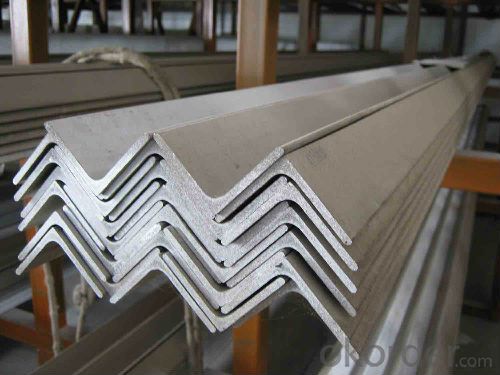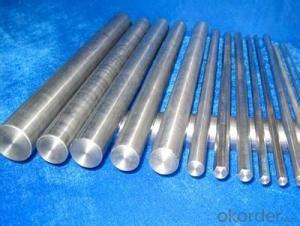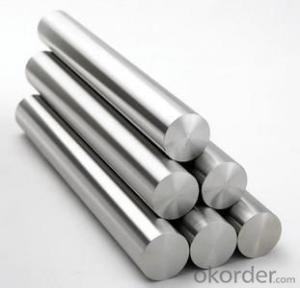Angle Steel Hot Rolled GB Q235 OR Q345 20MM-250MM
- Loading Port:
- China Main Port
- Payment Terms:
- TT or LC
- Min Order Qty:
- -
- Supply Capability:
- -
OKorder Service Pledge
OKorder Financial Service
You Might Also Like
Product Description:
OKorder is offering high quality Angle Steel Hot Rolled GB Q235 OR Q345 20MM-250MM at great prices with worldwide shipping. Our supplier is a world-class manufacturer of steel, with our products utilized the world over. OKorder annually supplies products to European, North American and Asian markets. We provide quotations within 24 hours of receiving an inquiry and guarantee competitive prices.
Product Applications:
According to the needs of different structures, Angle can compose to different force support component, and also can be the connections between components. It is widely used in various building structures and engineering structures such as roof beams, bridges, transmission towers, hoisting machinery and transport machinery, ships, industrial furnaces, reaction tower, container frame and warehouse etc
Product Advantages:
OKorder's Steel Angle Steel Hot Rolled GB Q235 OR Q345 20MM-250MM are durable, strong, and resist corrosion.
Main Product Features:
· Premium quality
· Prompt delivery & seaworthy packing (30 days after receiving deposit)
· Corrosion resistance
· Can be recycled and reused
· Mill test certification
· Professional Service
· Competitive pricing
Product Specifications:
Manufacture: Hot rolled
Grade: Q195 – 235
Certificates: ISO, SGS, BV, CIQ
Length: 6m – 12m, as per customer request
Packaging: Export packing, nude packing, bundled
Sizes: 25mm-250mm | ||||||||||||
a*t | ||||||||||||
25*2.5-4.0 | 70*6.0-9.0 | 130*9.0-15 | ||||||||||
30*2.5-6.6 | 75*6.0-9.0 | 140*10-14 | ||||||||||
36*3.0-5.0 | 80*5.0-10 | 150*10-20 | ||||||||||
38*2.3-6.0 | 90*7.0-10 | 160*10-16 | ||||||||||
40*3.0-5.0 | 100*6.0-12 | 175*12-15 | ||||||||||
45*4.0-6.0 | 110*8.0-10 | 180*12-18 | ||||||||||
50*4.0-6.0 | 120*6.0-15 | 200*14-25 | ||||||||||
60*4.0-8.0 | 125*8.0-14 | 250*25 | ||||||||||
FAQ:
Q1: Why buy Materials & Equipment from OKorder.com?
A1: All products offered byOKorder.com are carefully selected from China's most reliable manufacturing enterprises. Through its ISO certifications, OKorder.com adheres to the highest standards and a commitment to supply chain safety and customer satisfaction.
Q2: How do we guarantee the quality of our products?
A2: We have established an advanced quality management system which conducts strict quality tests at every step, from raw materials to the final product. At the same time, we provide extensive follow-up service assurances as required.
Q3: How soon can we receive the product after purchase?
A3: Within three days of placing an order, we will begin production. The specific shipping date is dependent upon international and government factors, but is typically 7 to 10 workdays.


- Q:Can steel angles be used in seismic-resistant structures?
- Seismic-resistant structures can incorporate steel angles for various purposes. These versatile elements are commonly utilized in buildings and bridges due to their high strength. In seismic-resistant structures, steel angles can be employed in multiple ways to bolster the overall structural integrity and earthquake resistance. When used as bracing elements, steel angles play a crucial role in distributing and dissipating seismic forces. By connecting them diagonally between different structural components, the impact on the structure can be significantly minimized. This prevents excessive deformation or collapse during an earthquake. Moreover, steel angles can reinforce and strengthen key components of the structure. They can be welded or bolted to beams and columns, providing additional support and stiffness. This reinforcement enables the structure to better withstand lateral forces generated by earthquakes, ultimately improving its seismic performance. In the construction of moment-resisting frames, steel angles are essential components. These frames are widely employed in seismic-resistant structures. By utilizing steel angles as the main elements, rigid connections between beams and columns are created. This allows for effective transfer and distribution of seismic forces, reducing structural damage and enhancing earthquake resistance. It is important to adhere to relevant building codes and regulations when incorporating steel angles into seismic-resistant structures. The specific design and detailing requirements may vary depending on the seismic zone and potential earthquake magnitudes. Consulting with structural engineers and following appropriate guidelines is crucial to ensure the safe and effective utilization of steel angles in these structures.
- Q:How do steel angles perform in extreme weather conditions?
- Steel angles are designed to be highly durable and resistant to extreme weather conditions. They are commonly used in construction and structural applications due to their strength and ability to withstand harsh environments. In extreme weather conditions such as hurricanes, heavy snowfall, or high winds, steel angles provide excellent protection against these elements. One of the key factors that contribute to the performance of steel angles in extreme weather conditions is their high tensile strength. Steel angles can withstand substantial loads and forces without deforming or breaking, making them ideal for withstanding extreme weather events. Additionally, steel angles are known for their excellent resistance to corrosion, which is crucial in areas with high humidity, saltwater, or acidic environments. Steel angles are also highly versatile, allowing them to be easily fabricated and customized to meet specific project requirements. This flexibility ensures that they can be used in a wide range of applications, including buildings, bridges, towers, and other structures that are exposed to extreme weather conditions. Moreover, steel angles can be coated or treated to further enhance their weather resistance. For example, a galvanized coating can provide added protection against rust and corrosion, extending the lifespan of the steel angles even in the harshest weather conditions. In summary, steel angles are designed to perform exceptionally well in extreme weather conditions. Their high tensile strength, corrosion resistance, and versatility make them a reliable choice for structures that need to withstand hurricanes, heavy snowfall, high winds, and other challenging weather events.
- Q:Can steel angles be used in outdoor or exposed environments?
- Yes, steel angles can be used in outdoor or exposed environments. Steel angles are often made of galvanized steel, which is coated with a protective layer of zinc to prevent rusting. This makes them highly resistant to corrosion and suitable for outdoor applications. Additionally, steel angles are known for their strength and durability, making them a reliable choice for various outdoor structures, such as fences, railings, and supports. However, it is important to note that regular maintenance and inspection may be required to ensure the ongoing integrity and performance of steel angles in outdoor or exposed environments.
- Q:How do steel angles perform under wind loads?
- Structural support and stability are provided by steel angles commonly used in construction. The reliability and effectiveness of steel angles in withstanding wind loads have been proven. The shape and design of steel angles enable them to resist the force exerted by wind, preventing any notable deformation or failure. Under wind loads, the force is evenly distributed along the length of steel angles, transferring it to other connected structural elements. This minimizes the potential for localized stress concentrations and guarantees the overall stability of the structure. Steel angles possess high strength and stiffness, enabling them to resist bending and twisting forces caused by wind. This is especially crucial in areas prone to high wind speeds or in tall buildings where wind loads can be more substantial. The rigidity of steel angles ensures the structure's integrity and prevents excessive deflection or deformation. Additionally, steel angles can be easily connected to other structural components using various methods such as welding, bolting, or riveting. This allows for a secure and reliable connection that can endure wind loads without compromising the overall strength and stability of the structure. To summarize, steel angles excel under wind loads due to their shape, strength, and rigidity. They efficiently distribute wind forces and maintain structural stability, making them a dependable choice for construction projects in wind-prone areas or for structures requiring significant wind load resistance.
- Q:Are steel angles resistant to chemicals?
- Yes, steel angles are generally resistant to chemicals due to their high durability and corrosion resistance. However, their resistance may vary depending on the specific type of chemical and environment they are exposed to.
- Q:Can steel angles be cold-formed or bent to specific shapes?
- Indeed, it is possible to cold-form or bend steel angles to attain particular shapes. Cold forming refers to the act of reshaping metal without the application of heat, usually accomplished through techniques such as bending, rolling, or pressing. Steel angles, which consist of L-shaped steel components, can undergo cold forming to achieve diverse shapes and angles in accordance with project specifications. This procedure entails exerting force and pressure on the steel angle, resulting in its deformation and acquisition of the desired form. By employing cold forming techniques on steel angles, one can achieve design flexibility and customization while preserving the strength and durability of the steel material.
- Q:Can steel angles be used for solar panel installations?
- Yes, steel angles can be used for solar panel installations. Steel angles provide a strong and durable framework for mounting solar panels, ensuring stability and longevity.
- Q:Can steel angles be used for temporary structures or scaffolding?
- Certainly, temporary structures or scaffolding can make use of steel angles. Because of their strength and durability, steel angles find frequent employment in construction endeavors. They are regularly employed to furnish structural support and maintain stability in temporary structures and scaffolding arrangements. Steel angles possess versatility, allowing for effortless welding, bolting, or fastening, leading to the creation of robust and secure temporary structures or scaffolding setups. Furthermore, due to the assortment of sizes and thicknesses available, steel angles prove highly suitable for diverse temporary construction applications.
- Q:How does the weight of a steel angle affect its load-bearing capacity?
- The weight of a steel angle directly affects its load-bearing capacity. In general, a heavier steel angle has a higher load-bearing capacity compared to a lighter one. This is because the weight of the angle contributes to its overall strength and stability. When a load is applied to a steel angle, it creates both compressive and tensile forces within the material. The weight of the angle helps to distribute these forces evenly, minimizing the risk of deformation or failure. Additionally, a heavier steel angle typically indicates a higher density and a greater amount of material used in its construction. This means that the angle can withstand larger loads without undergoing significant deflection or structural damage. It is important to note that the load-bearing capacity of a steel angle is also influenced by other factors such as its dimensions, material properties, and the type of connection used. However, the weight of the angle remains a crucial consideration in determining its overall strength and ability to support loads.
- Q:What is the maximum span for a steel angle?
- Various factors, including the size, shape, and thickness of a steel angle, as well as the load it is anticipated to bear, determine its maximum span. Typically, greater maximum spans are achievable with larger and thicker steel angles. Nonetheless, it is crucial to refer to structural engineering standards, codes, and consult with professional engineers to ascertain the specific maximum span for a particular steel angle in a specific application. These specialists will take into account factors like the material's yield strength, deflection limits, and safety factors to offer precise guidelines for the maximum span.
1. Manufacturer Overview |
|
|---|---|
| Location | |
| Year Established | |
| Annual Output Value | |
| Main Markets | |
| Company Certifications | |
2. Manufacturer Certificates |
|
|---|---|
| a) Certification Name | |
| Range | |
| Reference | |
| Validity Period | |
3. Manufacturer Capability |
|
|---|---|
| a)Trade Capacity | |
| Nearest Port | |
| Export Percentage | |
| No.of Employees in Trade Department | |
| Language Spoken: | |
| b)Factory Information | |
| Factory Size: | |
| No. of Production Lines | |
| Contract Manufacturing | |
| Product Price Range | |
Send your message to us
Angle Steel Hot Rolled GB Q235 OR Q345 20MM-250MM
- Loading Port:
- China Main Port
- Payment Terms:
- TT or LC
- Min Order Qty:
- -
- Supply Capability:
- -
OKorder Service Pledge
OKorder Financial Service
Similar products
New products
Hot products
Related keywords




























